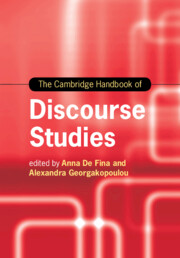Book contents
- The Cambridge Handbook of Discourse Studies
- Cambridge Handbooks in Language and Linguistics
- The Cambridge Handbook of Discourse Studies
- Copyright page
- Contents
- Figures
- Tables
- Contributors
- Preface
- Part I (Con)Textualizing Discourses
- Part II Perspectives and Modes of Analysis
- Part III Discourse Materialities and Embodiment
- Part IV (Trans)Locations and Intersections
- Part V Ethics, Inequality and Inclusion
- 21 Ethics and the Study of Discourse
- 22 Migrants, Citizenship and Language Rights
- 23 Diversity and Inclusion in Education
- 24 Discourse and Racialization
- 25 Discourse and Narrative in Legal Settings: The Political Asylum Process
- 26 Discourse and Religion in Educational Practice
- Part VI Discourses, Publics and Mediatization
- Index
- References
24 - Discourse and Racialization
from Part V - Ethics, Inequality and Inclusion
Published online by Cambridge University Press: 28 September 2020
- The Cambridge Handbook of Discourse Studies
- Cambridge Handbooks in Language and Linguistics
- The Cambridge Handbook of Discourse Studies
- Copyright page
- Contents
- Figures
- Tables
- Contributors
- Preface
- Part I (Con)Textualizing Discourses
- Part II Perspectives and Modes of Analysis
- Part III Discourse Materialities and Embodiment
- Part IV (Trans)Locations and Intersections
- Part V Ethics, Inequality and Inclusion
- 21 Ethics and the Study of Discourse
- 22 Migrants, Citizenship and Language Rights
- 23 Diversity and Inclusion in Education
- 24 Discourse and Racialization
- 25 Discourse and Narrative in Legal Settings: The Political Asylum Process
- 26 Discourse and Religion in Educational Practice
- Part VI Discourses, Publics and Mediatization
- Index
- References
Summary
This chapter discusses the idea that discourse is central to how race is culturally understood and the form it takes in different contexts. Through the notions of “racialization” and “racialized,” as the semiotic and ideological processes through which race comes to be produced and reified through language practices, it proposes to study ideological processes instead of fixed racial categories, which entails moving beyond the study of the ideology of racism towards the study of its ideological practice. This chapter also addresses the links between race and language that emerge dynamically through discursive practice. It sustains that language and race intersect in two main ways: in “racial discourse,” or discourse that takes race as its topic, and in “racialized linguistic practice,” or the use of language associated with specific racialized groups. It finally recommends integrating the different discursive approaches that address language and race under the wider perspective of language as social practice. This entails researching what race does in specific contexts through the understanding of how power relations emerge in local contexts, how people make sense of their social practices, and how wider social structures influence discursive practices.
- Type
- Chapter
- Information
- The Cambridge Handbook of Discourse Studies , pp. 527 - 546Publisher: Cambridge University PressPrint publication year: 2020
References
Further Reading
In this multi-authored work, Alim, Rickford and Ball introduce the concept of raciolinguistics, or how language and ideas about race intersect. In three sections, “Languaging Race,” “Racing Language” and “Language, Race, and Education in Changing Communities,” researchers from several global contexts offer new perspectives on racialization, racial malleability and marginalization, among other topics addressing race and discourse.
Back and Zavala situate Peruvian ideas about race and racialization in the overall context of Latin American scholarship on race. Each empirical study in this multi-authored work offers a unique glimpse into the complex construction of racialized identities and “race talk” in both real-world and virtual contexts.
This excellent chapter proposes three main approaches in the study of language, race and ideology: the distinctive ethnoracial language, the acts of ethnoracial identity and the racialization approach. It discusses critical issues for addressing the key role of language in semiotic processes of racialization.
This article establishes the research agenda of a raciolinguistics perspective after the groundbreaking article from Flores and Rosa (2015, see references). It theorizes the historical and contemporary co-naturalization of language and race and discusses five key components of this perspective.
In this book, the author discusses how racial ideas and structural racism permeate the lives of shantytown youth and people from the middle class in Rio de Janeiro, Brazil. She argues that the amount of whiteness or blackness a body displays is determined not only through observations of phenotypical features but also through attention paid to always malleable cultural and linguistic practices.
References
- 2
- Cited by



